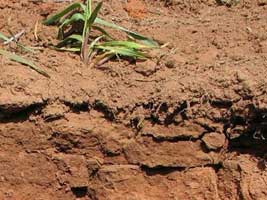Compaction
|
What is it? |  Photograph of a compacted zone of soil immediately below the plough layer in a cropping soil |
Impact
Compaction occurs as a result of trafficking and cultivation. It is exacerbated by high soil moisture contents.
The reduction in pore space (and it is usually the larger pores which are destroyed) decreases the habitat available for roots and soil organisms. As a consequence it reduces biological activity in the soil leading to decreasing rates of soil organic matter cycling and nutrient availability. It also decreases soil permeability, aeration, water holding capacity, drainage, seedling emergence and root exploration.
Management
The starting points to avoiding soil compaction are: minimise cultivation; avoid working soils when wet; reduce and control traffic, and contain animal movement on moist soils.


